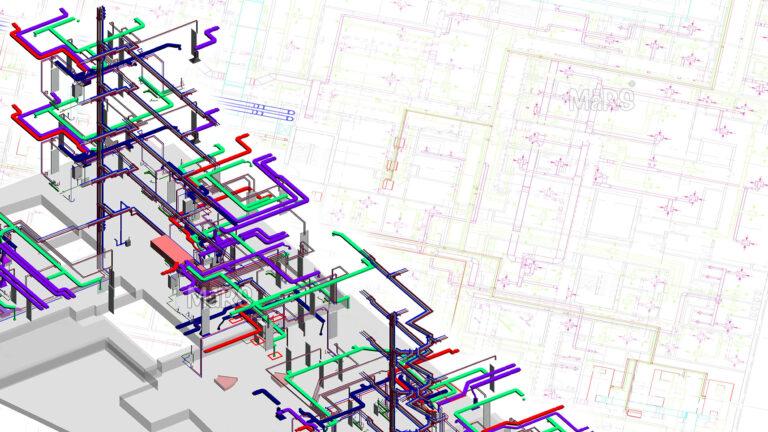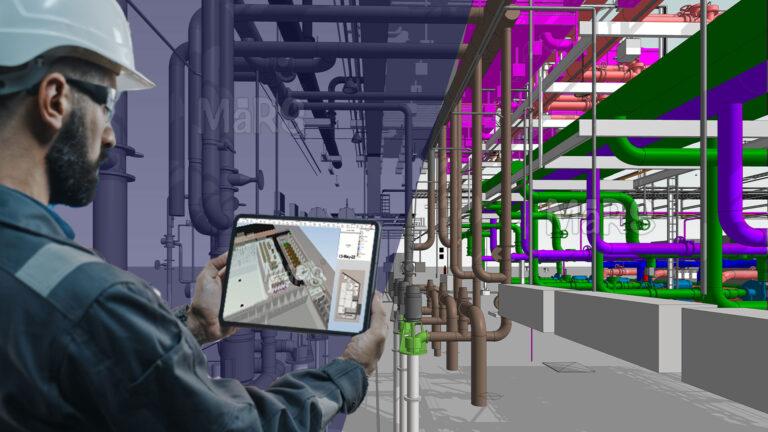In recent years, the construction industry has undergone rapid transformation. BIM has emerged as a vital tool in this evolution, revolutionizing the way projects are planned and executed. MEP contractors, in particular, have been quick to adopt BIM. But what is driving this accelerated adoption?
Why MEP Contractors Are Adopting BIM?
Enhanced Collaboration and Coordination
One of the most compelling reasons for MEP contractors to adopt BIM is the need for better collaboration. Several teams frequently team up on construction projects at the same time. BIM offers a unified platform for seamless collaboration among architects, engineers, and contractors.
By using BIM, MEP BIM Services become more efficient. BIM helps teams find and fix clashes early using clash detection tools. This reduces on-site conflicts and delays, ensuring MEP systems fit smoothly into the building.
Improved Accuracy and Efficiency
MEP Coordination Services creates 3D models of MEP systems, allowing contractors to visualize and plan every detail before construction starts.
Precise modeling helps contractors reduce design errors and improve material estimates. This leads to better planning, cost estimation, and resource allocation. Additionally, BIM helps contractors avoid costly rework by identifying potential issues early. The result is a smoother workflow and a significant reduction in time and expenses.
Faster Project Delivery
BIM speeds up construction for MEP contractors by creating detailed models that make off-site prefabrication easier. This reduces the time required for on-site installation and minimizes disruptions during construction.
By improving workflows and coordination, projects are finished on time or even earlier. This makes clients happy but also strengthens the contractor’s reputation and competitiveness.
Accurate Planning and Estimation
BIM allows for precise planning and estimation. MEP contractors can create precise 3D models to improve material and labor estimates, reduce waste, and optimize resources to stay on budget. 3D visualization also helps spot potential issues before they occur on-site.
Sustainability and Energy Efficiency
Sustainability is no longer a buzzword; it is a necessity in modern construction. BIM helps MEP contractors design systems that are energy-efficient and environmentally friendly. Contractors can use advanced tools to test system performance and improve designs to save energy.
BIM also enables precise material planning, minimizing waste during construction. BIM helps meet global goals and lowers costs for building owners, making it a great choice for everyone involved.
Staying Competitive
The construction industry is competitive, and staying ahead means using advanced technologies. Clients are increasingly demanding the use of BIM for project execution. MEP contractors who embrace BIM can meet these demands and gain a competitive edge.
By adopting BIM, contractors can showcase their ability to handle complex projects efficiently. This makes them trusted partners, helping them win more contracts and build lasting relationships.
Benefits of MEP Coordination Services

Besides MEP BIM services, MEP coordination services play a vital role in the success of projects. These services ensure the seamless integration of all MEP systems into the building design. Here are some key benefits:
- Clash Detection: BIM helps identify clashes between different systems early in the design phase. During construction, this proactive strategy reduces the need for expensive rework.
- Simplified Workflows: MEP coordination improves communication by using a single platform for all project data.
- Quality Control: With accurate as-built models generated through BIM, contractors can ensure that the final project meets all specifications and quality standards.
- Cost Optimization: Precise quantification of materials and optimized routing of MEP systems reduces procurement costs and on-site material wastage. Mitigates financial risks associated with construction rework and system redesign.
- Risk Management and Mitigation: Early identification of potential design and installation risks reduces the likelihood of costly delays and safety issues. Provides risk analysis and contingency planning for critical MEP systems.
- Spatial Optimization: 3D modeling and simulation tools ease the compact and efficient layout of MEP systems within limited spaces, maximizing usable areas. Avoids overdesign and ensures accessibility for maintenance and future upgrades.
- Lifecycle Asset Management: Delivers accurate as-built BIM models for facilities management, enabling predictive maintenance and streamlined asset tracking. Facilitates seamless upgrades and retrofits with comprehensive system documentation.
Challenges of BIM Adoption for MEP Contractors
MEP contractors face challenges when adopting BIM, making it harder to transition from traditional methods to this advanced technology. Understanding these challenges is crucial for improving project outcomes and enhancing efficiency.
1. Lack of Expertise
One of the most significant hurdles is the lack of expertise in BIM among MEP contractors. Many employees may not have the necessary skills or training to effectively use BIM software. The knowledge gap can cause inefficiencies and higher costs, making it harder for companies to realize the benefits of BIM adoption.
2. High Training Costs
Implementing BIM requires substantial investment in both software and training for staff. Many contractors view these costs as a burden rather than an investment in future efficiency. Fear of disrupting daily work during the transition can lead to resistance against adopting BIM.
3. Resistance to Change
Cultural resistance within organizations can significantly slow down BIM adoption. Employees used to traditional methods may resist new technologies, worrying about added responsibility and the pressure to perform perfectly. This reluctance can prevent companies from fully realizing the potential benefits of BIM.
4. Coordination Challenges
MEP projects involve multiple stakeholders, like consultants and subcontractors, making coordination challenging. Traditional methods can lead to poor communication and data sharing, causing delays and confusion. Without a unified platform, design clashes and rework are common. Effective collaboration is key to avoiding these issues.
5. Data Overload
The sheer volume of data generated during a project can overwhelm teams. Many contractors struggle with filtering relevant information from the vast amount of data available, which can lead to confusion and inefficiency. Managing this data effectively is essential for successful BIM implementation.
6. Limited Spatial Understanding
MEP contractors often struggle to visualize how different systems fit into a building. 2D drawings don’t show how systems interact, causing design errors and clashes during construction. BIM’s 3D visualization capabilities can help mitigate this challenge but must shift in mindset and approach.
Strategies to Overcome BIM Implementation Challenges
MEP contractors face many challenges with BIM implementation, but there are key strategies to overcome them. Here are some key approaches that can facilitate a smoother transition to BIM.
1. Foster a Culture of Innovation
One of the most frequent obstacles to BIM adoption is resistance to change. To combat this, MEP contractors should create an environment that encourages innovation. This can be achieved by conducting workshops and training sessions that highlight the advantages of BIM. Sharing success stories from other projects can inspire staff to adopt new technologies and methods.
2. Invest in Training and Skill Development
A lack of skilled workforce is a significant barrier to BIM implementation. MEP contractors should invest in training programs to help employees gain essential BIM skills. Partnering with schools to create relevant courses can also build a skilled workforce. Hiring experienced BIM specialists can guide the transition and mentor existing staff.
3. Enhance Collaboration Among Stakeholders
Effective collaboration is crucial for successful BIM implementation. MEP contractors should use collaborative methods like IPD or Design-Build to involve all team members early on. Cloud-based BIM tools allow real-time access to project data, improving communication and decision-making.
4. Address Interoperability Issues
Compatibility between different software tools can pose challenges in BIM adoption. MEP contractors should choose widely used software that works well with other project tools. Setting clear data standards and exchange rules improves communication and prevents data loss.
5. Develop Robust Data Management Strategies
BIM generates vast amounts of data, making effective data management essential. MEP contractors should establish clear guidelines for data entry, storage, and sharing to ensure accuracy and consistency. Using a central data hub improves team collaboration and makes data easier to access, while regular checks help maintain data quality.
6. Secure Leadership Support
Strong leadership support is vital for successful BIM implementation. MEP contractors should educate management on BIM’s benefits, like better efficiency and lower costs. Involving executives in planning helps secure the attention and resources BIM needs.
7. Start with Pilot Projects
To manage high initial investment costs, MEP contractors can begin by implementing BIM on smaller pilot projects. This approach helps teams spot issues and improve workflows before fully using the technology, reducing risks.
Conclusion
BIM is no longer a tool of the future; it is a necessity for the present. For MEP contractors, it provides great benefits in collaboration, accuracy, efficiency, and sustainability.
By using MEP BIM and Coordination Services, contractors can confidently handle complex projects. As the construction industry evolves, adopting BIM is crucial for success. Embracing this technology helps MEP contractors stay innovative and meet the changing market demands.









